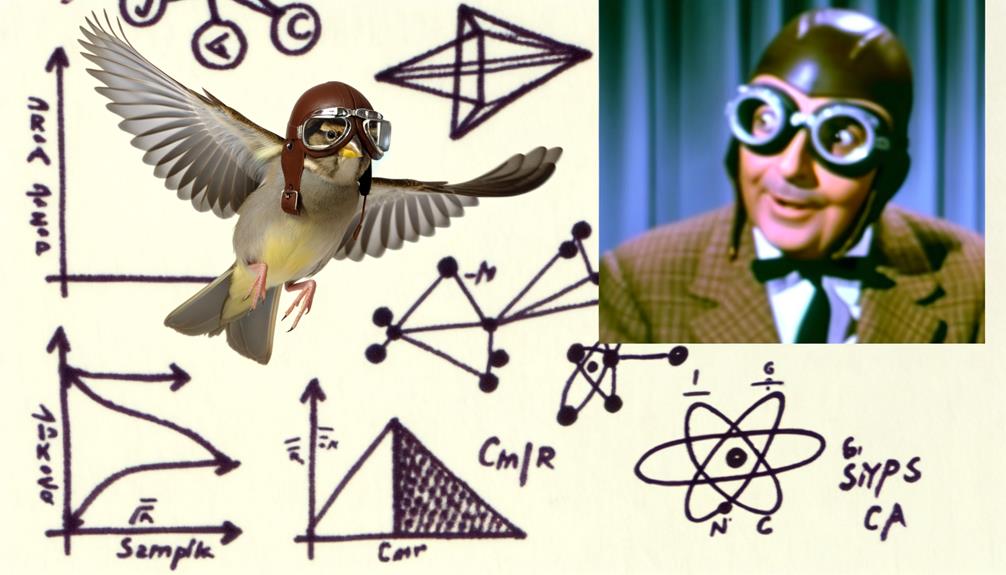5 Fun Facts About How Fast the Monty Python Sparrow Flies
In Monty Python's 'Monty Python and the Holy Grail,' the whimsical inquiry into the airspeed velocity of an unladen swallow spurs interest in avian flight mechanics. Scientifically, sparrows achieve average flight speeds between 24 to 28 miles per hour.
This speed is influenced by wing morphology, muscle physiology, and environmental factors like wind speed and air density. The comedic sketch artfully blends humor with ornithological data, encouraging viewers to explore the intriguing dynamics behind seemingly simple questions.
This fascinating intersection of comedy and science provides a rich avenue for further exploration into avian biomechanics.

Key Takeaways
- Sparrows typically fly at speeds between 24 to 28 miles per hour.
- The Monty Python sketch humorously questions the airspeed velocity of an unladen swallow, not a sparrow.
- Flight speeds are influenced by factors such as wing morphology, muscle strength, and environmental conditions.
- The average cruising speed of an unladen European swallow is around 24 miles per hour.
- Monty Python uses humor to blend scientific curiosity with whimsical elements in their sketches.
The Monty Python Connection

In the domain of comedic inquiry, Monty Python's iconic sketch, 'Monty Python and the Holy Grail,' irreverently poses the question, 'What is the airspeed velocity of an unladen swallow?' This seemingly whimsical query has intrigued both fans and scientists alike, prompting a closer examination of avian flight mechanics.
Monty Python's humor cleverly intersects with ornithological studies, emphasizing the relevance of species-specific parameters such as wing morphology and weight. By dissecting these factors, one can derive the approximate velocity of different swallow species. Consequently, the sketch not only entertains but also stimulates intellectual curiosity, inviting a scientific exploration of flight dynamics.
This intersection of comedy and science exemplifies how humor can effectively bridge gaps between popular culture and academic discourse.
The Famous Question
Posed in a seemingly nonsensical context, the question about the airspeed velocity of an unladen swallow actually serves as a fascinating entry point for examining the principles of avian flight mechanics. This inquiry, immortalized by Monty Python, invites us to explore into the intricate dynamics of bird flight. Factors such as wing morphology, muscle strength, and air resistance play significant roles in determining flight speed.
Specifically, the unladen swallow's speed is influenced by its wing span, wing loading, and the frequency of wing beats. Understanding these elements not only satisfies a whimsical curiosity but also enriches our comprehension of biomechanics and aerodynamics. This exploration underscores the complexity behind what might initially appear to be a trivial question.
Sparrow Flight Speed

To scientifically determine the flight speed of a sparrow, one must consider factors such as wing structure, muscle physiology, and environmental conditions.
Wing structure, including wing loading and aspect ratio, directly impacts lift and maneuverability. Sparrows typically exhibit a low wing loading, facilitating agile flight.
Muscle physiology, particularly the composition of fast-twitch muscle fibers, enables rapid wingbeat frequencies essential for sustained flight speeds.
Environmental conditions such as wind speed, air density, and temperature also influence flight performance.
Empirical studies indicate that sparrows can achieve average flight speeds between 24 to 28 miles per hour. However, variations in individual fitness and situational factors can lead to deviations from this range, underscoring the complexity of accurately quantifying avian flight speed.
Swallow Airspeed Velocity
Quantifying the airspeed velocity of a swallow necessitates an examination of species-specific flight mechanics, including wing morphology, muscle dynamics, and the aerodynamic properties of their flight patterns.
The European swallow (Hirundo rustica) exhibits a streamlined body and pointed wings, optimizing it for sustained, efficient flight. Research indicates that the average cruising speed of an unladen European swallow is approximately 11 meters per second (24 miles per hour).
This velocity is influenced by factors such as wingbeat frequency, which typically ranges from 12 to 17 beats per second, and the bird's ability to exploit aerodynamic lift and thrust.
Science Meets Humor

The juxtaposition of scientific inquiry and comedic interpretation, as exemplified by Monty Python's infamous 'What is the airspeed velocity of an unladen swallow?' sketch, underscores the intriguing intersection of factual aerodynamics and satirical humor.
This iconic scene prompts us to ponder the actual physics behind avian flight while simultaneously appreciating the absurdity of the question within its comedic context. Scientifically, the airspeed velocity of an unladen European swallow (Hirundo rustica) has been estimated at approximately 11 meters per second, or 24 miles per hour.
However, Monty Python cleverly exploits the complexity of this question, blending precise ornithological data with whimsical banter. This blend not only entertains but also invites audiences to engage with scientific topics in a light-hearted manner.
Conclusion
The intersection of Monty Python's humor and ornithological facts demonstrates how scientific inquiry can be as intricate and precise as a finely tuned clock.
The iconic question about sparrow flight speed encapsulates this blend of comedy and curiosity.
While the airspeed velocity of an unladen swallow is approximately 11 meters per second, the detailed analysis of a sparrow's flight remains a complex task, illustrating the meticulous nature of both scientific research and comedic writing.






